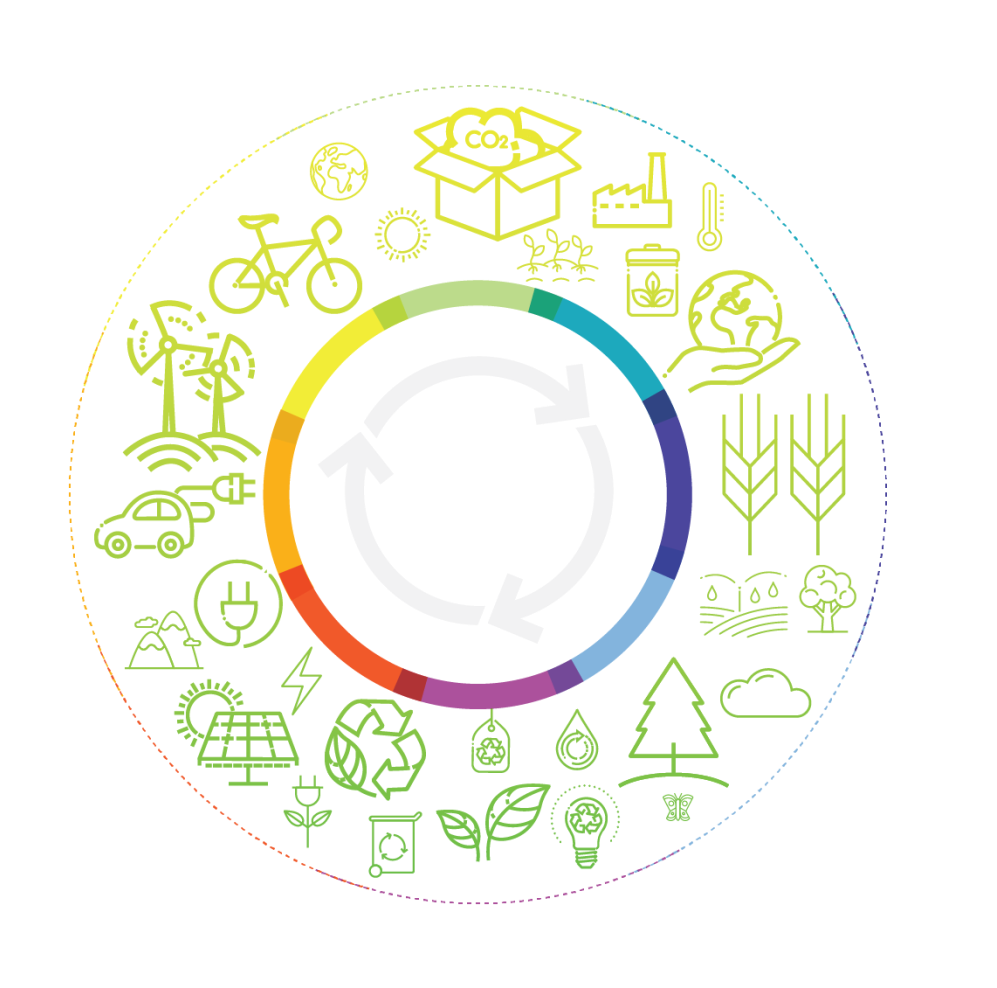
On Wednesday 28 November 2018, the European Commission adopted a strategic long-term vision for a climate neutral economy (net-zero emissions) by 2050! A Clean Planet for All, tactically released ahead of the 24th Conference of the Parties (COP 24), which will be hosted in Katowice, Poland from 2-14 December, describes seven overarching areas that require action and eight different scenarios that allow the EU to significantly reduce emissions.
The EU is currently responsible for approximately 10% of global greenhouse gas emissions and is looking to become a world leader in the transition towards climate neutrality – a state where the amount of emissions produced is equal to that sequestered [1]. A Clean Planet for All highlights how the EU can reduce its emissions and, in two of the eight scenarios outlined, have a climate neutral economy by 2050.
A Clean Planet for All is a leap toward a climate neutral economy but it does not intend to launch new policies, nor alter the 2030 climate & energy framework and targets that are already in place. Instead, it will use these targets as a baseline while simultaneously setting the direction of EU policies so that they align with the Paris Agreement’s temperature objectives, help achieve the UN’s Sustainable Development Goals and improve the EU’s long-term prosperity and health.
What role did science play in the Clean Planet for All strategy?
Reports generated using climate research, such as the Intergovernmental Panel on Climate Change (IPCC)’s Special Report on Global Warming of 1.5ºC, have been catalysts in national climate strategies and policies around the world. This is holds true for the EU’s A Clean Planet for All which features quotes and statistics from the IPCC’s 1.5ºC Report.
International treaties and targets set by organisations such as the United Nations also put pressure on national and regional governments to act and implement their own polices to reduce emissions. Many of these treaties and global targets are based on scientific reports that describe the current state of the world and give projections based on future scenarios. One of the most noteworthy examples of a global treaty is the Paris Agreement which was ratified by 181 counties in 2015. The Sustainable Development Goals are an example of global targets created using a breadth of scientific studies and that are a major consideration when national and local governments are creating policy.
More directly, A Clean Planet for All’s eight different scenarios and their likely outcomes required a huge amount of research and calculations – these scenarios are outlined in more detail below. External scientific input was also employed with scientists and other stakeholders given the opportunity to contribute to the proposal. An EU Public Consultation was open from 17 July until 9 October 2018 and received over 2800 responses. There was also a stakeholder event on 10-11 July 2018 that brought together stakeholders from research, business and the public to discuss the issues with the upcoming strategy.
The 7 strategic building block for a climate neutral economy
A Clean Planet for All outlines seven building blocks that will enable Europe to reduce emissions and build a climate neutral economy.
- Energy efficiency
- Renewable energy
- Clean, safe and connected mobility
- Competitive industry and circular economy
- Infrastructure and interconnections
- Bio-economy and natural carbon sinks
- Carbon capture and storage

Figure 1: Achieving a climate neutral economy will require changes in all sectors. Source: EU Commission [3]
Scenarios toward climate neutrality
The Clean Planet for All strategy describes eight different scenarios or pathways that range from an 80% cut in emissions to net-zero emissions by 2050 (see Figure 2 below). Regardless of the scenario chosen, the Commissioner for Climate Action and Energy, Miguel Arias Cañete, emphasised that the structure of the strategy will give member states a certain amount of flexibility to follow different paths. The eight options outlined in the strategy are “what if-scenarios”. They highlight what is likely to happen with a given combination of technologies and actions. While all eight scenarios will enable the EU to reduce emissions, only the last two (shown in the figure below) provide Europe with the opportunity to build a carbon neutral economy by 2050.
The first five scenarios all focus on initiatives which foster a transition towards a climate neutral economy with the extent that electrification, hydrogen, e-fuels and energy efficiency is implemented and the role that the circular economy will play, being the variable. The anticipated electricity consumption required in 2050 also differs depending on the option selected. The energy efficiency and circular economy options have a greater focus on reducing the energy demand rather than developing new sources of clean energy and therefore require the lowest increase in electricity generation (approximately 35% more by 2050 compared with today). Despite the differences, the first five scenarios will all only achieve 80 – 85% emission reductions by 2050 compared with 1990, 15% short of a climate neutral economy.
The sixth scenario combines the first five options but at lower levels and reaches an emissions reduction of up to 90%. The seventh and eighth scenarios are the only ones that could lead to net-zero emissions by 2050. The seventh option combines the first four options and negative emissions technology such as carbon capture and storage. The eighth scenario builds on the seventh with an additional focus on circular economy, encouraging less carbon intensive consumer choices and strengthened carbon sinks via land use changes.
Figure 2: Overview of A Clean Planet for All’s 8 different scenarios to a climate neutral economy [3]
What about the economic cost?
The EU has allocated approximately 20% of its overall 2014-2020 budget (over €206 billion) to climate change-related action. This covers areas such as research and innovation, energy efficiency, public transport, renewable energy, network infrastructure, just to name a few. To achieve a climate neutral economy by 2050, the EU has proposed to raise the share spent on climate-related action to 25% (€320 billion) for the 2021-2027 period.
This is a significant increase but it’s also a smart investment! Not only will it help the EU reach net-emissions but it’s also expected to lower energy bills, increase competitiveness and stimulate economic growth with an estimated GDP increase of up to 2% by 2050. It will also help to reduce the financial impacts of climate change such as damages from increased flooding, heatwaves and droughts. According to a study published in 2018 by the Joint Research Centre, 3ºC of warming (likely in a business-as-usual scenario), would cut Europe’s GDP by at least €240 billion annually by the end of the century. That estimate drops to €79 billion with 2ºC of warming.
Fighting for a climate neutral economy is is expected to have a net-positive impact on employment but of course, some sectors and regions will see job losses. However, the EU has already outlined programmes to manage this issue, such as the European Social Fund Plus (ESF+), and the European Globalisation Adjustment Fund (EGF). As Miguel Arias Cañete (Commissioner for Climate Action and Energy), states:
“Going climate neutral is necessary, possible and in Europe’s interest.”
What are the next steps?
The strategy and scenarios will be discussed at COP24 and may even provide inspiration for other countries to implement similar strategies. You can keep an eye on COP24 developments by streaming sessions via the UNFCCC live webcast and by using #COP24 on social media.
Although already adopted by the European Commission, A Clean Planet for All still needs input and approval from the European Council, the European Parliament’s Environment Committee, the Committee of the Regions and the Economic and Social Committee. According to the Paris Agreement, all 181 nations must submit their 2030 emissions targets by 2020 so it’s likely that comments from these committees will come in early 2019.
It’s likely that there will also be a number of stakeholder events in 2019, such as Citizens Dialogues that give scientists, businesses, non-governmental organisations and the public the opportunity to share their thoughts and be involved in the process. The EGU will provide updates on relevant opportunities as they arise. To receive these updates you can join the EGU’s database of expertise!
References and further reading
[2] Questions and Answers: Long term strategy for Clean Planet for All
[3] In-Depth Analysis in Support of The Commission Communication Com(2018) 773
New EU plan comes out fighting for ‘climate neutrality’ by 2050
Factsheet on the Long Term Strategy Greenhouse Gas Emissions Reduction
10 countries demand net-zero emission goal in new EU climate strategy




